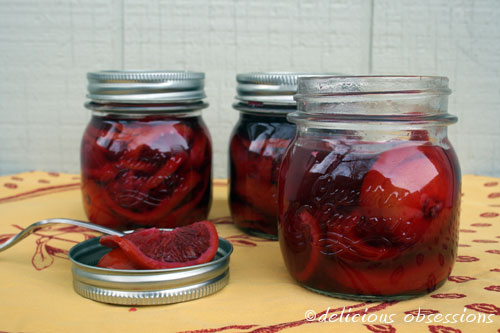FTC Disclosure: Delicious Obsessions may receive comissions from purchases made through links in this article. As an Amazon Associate I earn from qualifying purchases.Read our full terms and conditions here.
UPDATE 7/26/12: I no longer use whey as a starter for my ferments (learn why here). I also no longer use Mason jars for my ferments (learn why here). I use anaerobic fermenting jars exclusively and the improvement in the taste and texture of my ferments is unbelievable! I encourage everyone to take a look at the information regarding Mason jar ferments and come to a decision that best fits their family. I will be releasing updated versions of these recipes soon, as it applies to these jars. I recommend the anaerobic fermenting systems from The Probiotic Jar.
Welcome to week 6 of my journey through 52 weeks of bad a** bacteria. How are you doing so far on your probiotic food journey? Have you started eating more fermented and cultured foods? Have you noticed a difference in your health?
I’ve been having so much fun experimenting with different recipes and I feel like my gut is healthier from the increase in eating more fermented and cultured foods! 🙂
This week, I made some lacto-fermented orange marmalade, with a twist. Instead of the traditional Seville oranges that are most commonly used in marmalade, I used blood oranges and the marmalade is such a beautiful red color!
This recipe was inspired by Sally Fallon’s recipe in Nourishing Traditions. I’ve heard mixed reviews about this recipe. Some people like it, others don’t. The most important thing to remember when making this is that it’s not going to be a thick, jelly-like marmalade like most people are used to. It’s pretty liquidy, but it’s tasty (I think), nonetheless.
Since I did a pretty in-depth look at the nutrition of oranges in week 2, when I made lacto-fermented orange juice, I’m not going to go into that in this post. How about just a few facts about blood oranges?
Blood Orange Facts
- Blood oranges are much smaller than your typical orange. The ones I used were about the same size as a mandarin.
- The dark red color of the flesh comes from high amounts of anthocyanins, which are pigments common to flowers and fruit but are typically uncommon in citrus.
- The flesh of blood oranges develops the beautiful red color whenever the fruit is allowed to grow with cool nighttime temperatures (think tropical regions during the fall and winter).
- Blood oranges originated as a mutation of the sweet orange, most likely in the 18th century in either the Orient or the Southern Mediterranean.
This is not the kind of marmalade that you want to spread on your toast in the morning. The best way that I found to eat it was in salad dressing. You can add it to any citrus vinaigrette recipe, but I used the citrus vinaigrette that I put on my roasted beet and feta salad. I just replaced the lemon juice with the oranges marmalade (recipe below).
Lacto-Fermented Blood Orange Marmalade
makes 1 quart
Ingredients:
- 10-12 organic blood oranges (depending on the size)
- 1 tbsp. sea salt
- 1/4 cup whey
- 1/2 cup filtered water
- 1/4 cup organic cane sugar
Instructions:
1. Wash the oranges well. Since you’re going to be using the skins, you want to make sure they’re organic and very clean.
2. Thinly slice the oranges. You can leave them in full slices, or you can halve or quarter them.
3. Place the sliced oranges in a wide-mouth quart Mason jar and press down firmly to remove air pockets and release the juice. I used my clean hands, but beware, the blood orange juice stains!
4. Mix the salt, water, whey, and sugar together and whisk until the salt and sugar are dissolved.
5. Pour the liquid over the oranges. If it doesn’t quite cover them, add some more filtered water. You want the oranges to be about an inch below the top of the liquid and the liquid about an inch below the top of the jar.
6. Cover tightly with a lid and leave out at room temperature for 4-7 days, depending on the temperature of your kitchen.
7. Check the oranges daily to make sure they are still submerged below the liquid. If there are any spots of mold that appear, just gently skim off with a spoon. The product is still fine.
8. By day 3, you should notice some fizziness starting to appear. When I opened my jars on day 4, they were bubbling really good. I moved mine to the fridge on day 6.
Blood Orange Citrus Vinaigrette
makes 1/2 cup
Ingredients:
- 1/8 cup lacto-fermented blood orange marmalade
- 1/8 cup apple cider vinegar
- 1/4 cup olive oil
- 1 tbsp. fresh parsley, finely chopped
- dash of salt and pepper
Instructions:
1. Place all ingredients in a blender or food processor and blend until thoroughly combined.
So, tell me. Have you made lacto-fermented marmalade before? What’s your favorite way to incorporate it into your diet? Leave me a comment below!
Source: “Blood Orange“, Wikipedia


6 Comments